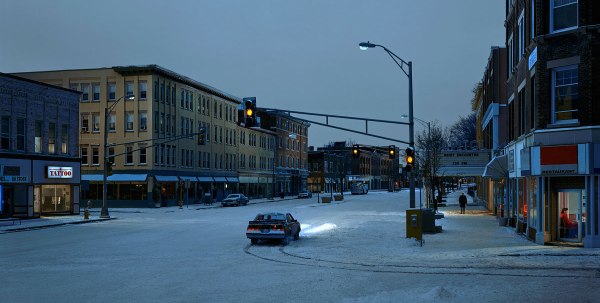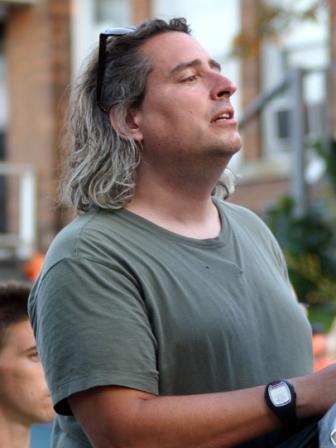 Back to selection
Back to selection
Five Questions with Gregory Crewdson: Brief Encounters Director Ben Shapiro

Ben Shapiro’s excellent Gregory Crewdson: Brief Encounters, opens tomorrow at Film Forum through Zeitgeist Films. The following interview was originally published on the eve of its SXSW Film Festival premiere.
Photographer Gregory Crewdson is renowned for his elaborately-staged photographs, huge in scope, size, and ambition. So filmmaker Benjamin Shapiro had his work cut out for him when he set out nearly a decade ago to follow Crewdson and demystify the artist’s process. But the biggest surprise of Shapiro’s long-awaited film is just how open, eloquent, and down-to-earth Crewdson is when discussing his art. Crewdson allows the audience unrestricted access to his shoots (not to mention his personal life), even taking us along as he searches for locations, subjects, and inspiration. Gregory Crewdson: Brief Encounters is a refreshingly frank look at the artistic process, as comprehensive and lovingly realized as the work it pays tribute to.

Filmmaker: When did you first discover Gregory Crewdson’s art? What about it inspired you to make this film?
Shapiro: I first discovered Gregory Crewdson when I filmed him for the PBS series EGG in 2000 (some of that footage is in the film). I admired the photographs, but it was also his process that originally drew me to the idea of making a film about him. When Crewdson takes the pictures, it’s almost a performance – him and his crew creating that “perfect moment” out in the world – in a sense his camera is just there to document that. The writer Russell Banks described the process as like watching an opera.
The other key to this project was that Gregory was very open and encouraging, and offered complete access of a kind that’s rare. He told me and his crew that I could shoot anywhere, anytime, and only asked me to back off when there was nudity on-set. Or if I got in their shot, which happened more than once!
Filmmaker: You’ve been working on this project for roughly a decade now. How have you seen Crewdson’s style develop over time?
Shapiro: It’s been fascinating watching his work and process evolve. Over the years I saw Crewdson’s productions grow larger, with their fantastic detail and craft. Then more recently, of course, he decided to end the really large-scale productions and work again with small crews. Without giving too much away that becomes a part of the arc of the film. I also saw his photographs change from using more fantastical imagery to what might be called more “naturalistic,” and, I would say, more subtly psychological work.
The first photograph of his I filmed was of a man climbing a flowering beanstalk bursting out of a suburban lawn. The last images in the movie, of the back-lot at Cinecitta, depict settings basically as he found them, and with no people in them at all.
 Filmmaker: Did working so closely with Crewdson for so long change the way you think about his art?
Filmmaker: Did working so closely with Crewdson for so long change the way you think about his art?
Shapiro: Following Crewdson over time has made me more thoroughly appreciate his overall process, from conceptualization to finish. I can’t really see his images apart from all that process, but that makes them more interesting to me. And it’s a radically different way of making an image as compared to documentary shooting! That contrast always interested me as well: the basically improvised nature of doc filming, against his process of image-making that’s so planned and thought out, but also very subjective.
Filmmaker: And how about your perception of the project itself – how has that evolved? Is the finished product similar to the film you originally set out to make?
Shapiro: When I started out I wasn’t sure what film I would make, I just wanted to start shooting and had the idea that a film would come out of it. I was excited by the challenge of covering the unfolding process of his picture-making, and of telling the story of a character that takes on challenges that are specifically visual and cinematic. Not all of his shoots end up as photographs, some fail in the sense he decides they just don’t work.
The device in the film of him narrating his story so much evolved as we did a series of lengthy interviews and informal chats, and those became more than just informational. They began to be him in a sense sifting through his origins as person and an artist.
Filmmaker: The way that Crewdson structures his shoots, at times he’s almost reminiscent of a director running a film set. Did his shooting style at all influence yours?
Shapiro: His shooting style influenced mine in part just that I had to respond to his process. His picture-taking is so elaborate – from the months of inventing and prep to all the components of the final shoot – that it was a challenge to find a way to cover it all. And then when you’re filming his shoots, you can’t help but be influenced by the look of his sets and of the light. For example, all his exterior pictures are taken at magic hour, so the climactic moments in the movie as he’s taking the pictures of course always have that same light.
I also invented some rules, such as when his pictures were being taken, I always had my camera on a tripod, the idea being it might help convey some different, more still and focused part of his process. The tone of his images, their sense of mystery and beauty, inspired me to find moments of those same qualities when we filmed.
